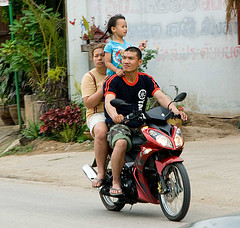How to Get Motorbiking Parents to Put Helmets on Their Kids?
Allison Zelkowitz, the Thailand program director for Save the Children, writes in to say:
I listen to your podcast frequently, and I was particularly interested by your show on the “herd mentality.”
Do you guys have any ideas to help me (and Save the Children in Thailand) figure out how to get parents to put helmets on their children in Thailand (or in other parts in the developing world?)
Thailand ranks worst in the world for motorbike and two-wheeler casualties, with more than 11,000 motorbike drivers or passengers dying annually. Traffic accidents are one of the highest causes of death for children in Thailand. Helmet wearing is low overall, but it is particularly low for children – it is common to see parents wearing helmets on a motorcycle with children who are not.
This, as you can imagine, blows my mind. Save the Children is working to design a program to address this, and as a result of your program on the herd mentality, I’m seriously considering trying to video parents at intersections and project large images of them on screens at the same intersection, with “thumbs down” signs when their kids aren’t wearing helmets (similar to the “shaming” you mentioned on your show.)
Any other ideas on how we could change parents behavior in this regard would be so appreciated!
I replied:
I’d suggest experimenting with a number of efforts (i.e., simultaneously) in order to try to fix the problem as quickly and cheaply as possible. There are probably a lot of ideas in that “herd mentality” episode that might be worth trying, from shaming to the “social norm” pressure of letting people know (or think) that everybody else does put a helmet on kids. Also I wouldn’t discount the use of shock tactics as well (grisly pix, e.g.).
She replied:
Your idea of trying a number of fixes simultaneously is a good one – this is not usually the way international NGOs do things, we design a program, see how it goes, then adjust. Thanks for the reminder that simultaneous experimentation can be more effective (I’m reading the book Decisive now, which also mentions this methodology).
Our partner, the Global Road Safety Partnership, had told me previously that scare tactics (similar to gruesome photos on cigarette packs) haven’t had much success with road safety initiatives, though I’ll check in with him again and see if there is any evidence for this working in Thailand or not.
All right, readers — what good advice do you have for Allison and Save the Children?


Comments